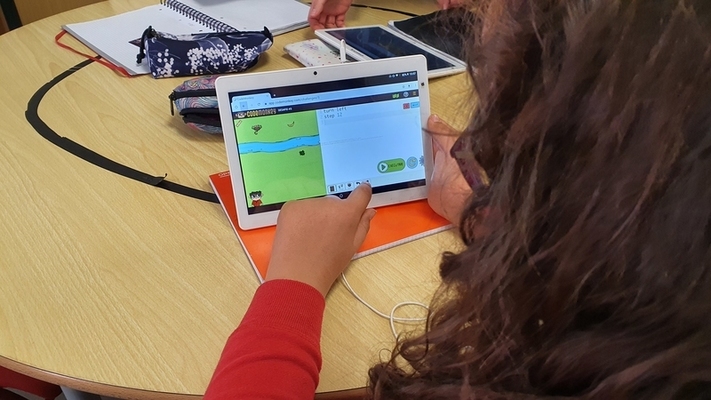José Marques
Learning Geometry with games and coding
This activity was developed with students from the 6th grade in the Future Classroom Lab, of Pedro Jacques de Magalhães school in Alverca. The work aimed to develop concepts related to the discipline of mathematics (Geometry - angles) and programming, using tablets.
The goals of the activity were as follows:
- to develop logical reasoning,
- to apply the following concepts:
- angle;
- measuring angles.
- positive/negative rotation;
- clockwise / counterclockwise;
- corresponding angles;
- alternate angles, external alternates, and measurements.
For the development of the activity, we use:
- Application Hour of Code - "CodeMonkey";
- Activity script "Paper Geometry".
Development
Before starting the activity, itself, I started working in the classroom with the students on the concepts indicated. We did a practical exercise in which the students "programmed" the teacher to take a course in the classroom. This route would have to include clockwise and counterclockwise rotations and angle ranges. Example: Walk 10 steps and rotate 90º clockwise and so on.
After this, each student opens the app on the tablet and start to pass the 30 levels of the game. Alone each student understands the concept of negative/positive rotation and clockwise/counterclockwise concept. This activity starts in the classroom and ends at home. After this activity, students, in pairs, do the script (coding on paper).


Conclusion
The results were surprising by the positive. In addition to the motivation of the students, I realized that when programming on paper the students effectively applied the desired concepts according to the programming logic. Even some asked if they could write the "repeat" commands in the programming. Students with greater difficulties actively developed the activity and with good results.



One of the limitations was time. CodeMonkey activity was introduced in the classroom, with the help of Microsoft Teams " Tasks," individually students continued their work at home (90% of all the students involved in the activity). As regards the paper activity, it took place during two 50-minute classes. During the activity, the concepts envisaged were worked on.

################################################
The method by which a teacher can measure precipitation. No complicated devices required. Can be used in math lessons.
Lithuania_the geometry of rain and snow.pdf
In discussing the activities of this method, students suggested making their own precipitation collection and measuring vessels with a 3D printer.
It is a great idea! We will implement it.
################################################
The strategy in this class was as follows: Half of the class performs an autonomous work of content consolidation using Teams and OneNote. The other part of the class performs the challenge of maps. In the second hour, they change the tasks. Students explore the environment in which they live.
More about methods
Portugal_2 challenges.pdf
################################################
This activity was developed with students from the 6th year of schooling in the Innovative Educational Environment, of the Group of Schools Pedro Jacques de Magalhães in Alverca. The work aimed to develop concepts related to the discipline of mathematics( Geometry - angles ) and programming, using tablets.
More about method
Portugal_geometry and programming.pdf
###############################################
Ruta Krikstopaitiene, Lithuania
The method focuses on measurements of the human body. Students are encouraged to explore body proportions and to test the correctness of some hypotheses. The material is intended for the teacher-practitioner.
maths of the human's body.docx
maths of the human's body.pdf
##############################################
Ruta Krikstopaitiene, Lithuania
A method that combines educational subjects in high school and 3D printing. The method that raises students' motivation, interest and creativity. There are examples of practical tasks.
3D printing integration method.pdf
